
Chiloé Island also known as Greater Island of Chiloé, is the largest island of the Chiloé Archipelago off the west coast of Chile, in the Pacific Ocean. The island is located in southern Chile, in the Los Lagos Region.

The Battle of Chacabuco, fought during the Chilean War of Independence, occurred on February 12, 1817. The Army of the Andes of the United Provinces of the Río de la Plata, led by Captain–General José de San Martín, defeated a Spanish force led by Rafael Maroto. It was a defeat for the Captaincy General of Chile, the royalist government established after the division of the Viceroyalty of Peru.

Castro is a city and commune on Chiloé Island in Chile. Castro is the capital of the Chiloé Province in the Los Lagos Region. The city is located on Estero de Castro on the eastern coast of central Chiloé Island. This position provides Castro with a good access to the eastern islands of Chiloé Archipelago as well as to the open ocean through Cucao and Huillinco to the west.

The Battle of Abtao was a naval battle fought on February 7, 1866, during the Chincha Islands War, between a Spanish squadron and a combined Peruvian-Chilean fleet, at the island of Abtao in the Gulf of Ancud near Chiloé Archipelago in south-central Chile. It was limited to a long-range exchange of fire between the two squadrons, as the allied ships, anchored behind the island, were protected by shallow waters inaccessible to the Spanish ships, whose gunnery, nevertheless, proved more accurate and inflicted damage to the Chilean and Peruvian ships.
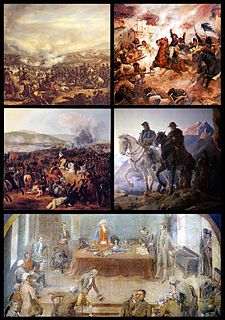
The Chilean War of Independence was a military and political event that allowed the emancipation of Chile from the Spanish Monarchy, ending the colonial period and initiating the formation of an independent republic.

William Miller known throughout Latin America as Guillermo Miller, was an English-born soldier who participated in several South American revolutions, and then became a diplomat.
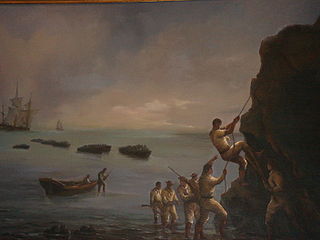
The Capture of Valdivia was a battle in the Chilean War of Independence between Royalist forces commanded by Colonel Manuel Montoya and Fausto del Hoyo and the Patriot forces under the command of Thomas Cochrane and Jorge Beauchef, held on 3 and 4 February 1820. The battle was fought over the control of the city Valdivia and its strategic and heavily fortified harbour. In the battle Patriots gained control of the southwestern part of the Valdivian Fort System after an audacious assault aided by deception and the darkness of the night. The following day the demoralised Spanish evacuated the remaining forts, looted local Patriot property in Valdivia and withdrew to Osorno and Chiloé. Thereafter, Patriot mobs looted the property of local Royalists until the Patriot army arrived to the city restoring order.

The Chiloé Archipelago is a group of islands lying off the coast of Chile, in the Los Lagos Region. It is separated from mainland Chile by the Chacao Channel in the north, the Sea of Chiloé in the east and the Gulf of Corcovado in the southeast. All islands except the Desertores Islands form Chiloé Province. The main island is Chiloé Island. Of roughly rectangular shape, the southwestern half of this island is a wilderness of contiguous forests, wetlands and, in some places, mountains. The landscape of the northeastern sectors of Chiloé Island and the islands to the east is dominated by rolling hills, with a mosaic of pastures, forests and cultivated fields.

The Chono people, or Guaiteco were a nomadic indigenous people or group of peoples of the archipelagos of Chiloé, Guaitecas and Chonos.

The Battle of El Toro was a battle fought near Maullín, Chile between Chilean patriots and Spanish royalists, during the Chilean War of Independence.

The Battle of Lagunillas was a battle in the Arauco War on November 8, 1557, between the army of García Hurtado de Mendoza and the Mapuche army near some shallow lakes a league south of the Bio-Bio River.
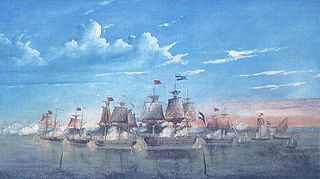
The Battle of Martín García was fought from 10 to 15 March 1814 between the forces of the United Provinces of the Río de la Plata under the command of then-Lieutenant Colonel Guillermo Brown, and the royalist forces commanded by frigate captain Jacinto de Romarate, defending the region.

The Battle of Mocopulli was fought on April 1 of 1824 as the culmination of a Chilean patriots invasion plan against royalist Chiloé. The battle concluded in a royalist victory that delayed the incorporation of Chiloé into Chile to 1826 when a new invasion was launched.

The Balanguingui Expedition of 1848 was an amphibious campaign organized by Governor General Narciso Clavería y Zaldúa to capture Balanguingui Island in the Sulu Archipelago from the Moro Pirates, who were using it as a base for their piratical activities.
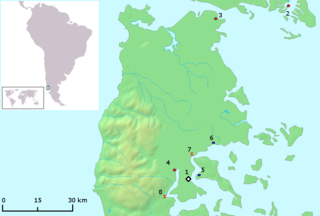
The Huilliche uprising of 1712 was an indigenous uprising against the Spanish encomenderos of the Chiloé Archipelago, which was then a part of the Captaincy General of Chile. The rebellion took place in the central part of the archipelago.
The history of Chiloé, an archipelago in Chile's south, has been marked by its geographic and political isolation. The archipelago has been described by Renato Cárdenas, historian at the Chilean National Library, as “a distinct enclave, linked more to the sea than the continent, a fragile society with a strong sense of solidarity and a deep territorial attachment.”

The Dutch expedition to Valdivia was a naval expedition, commanded by Hendrik Brouwer, sent by the Dutch Republic in 1643 to establish a base of operations and a trading post on the southern coast of Chile. With Spain and the Dutch Republic at war, the Dutch wished to take over the ruins of the abandoned Spanish city of Valdivia. The expedition sacked the Spanish settlements of Carelmapu and Castro in the Chiloé Archipelago before sailing to Valdivia, having the initial support of the local natives. The Dutch arrived in Valdivia on 24 August 1643 and named the colony Brouwershaven after Brouwer, who had died several weeks earlier. The short-lived colony was abandoned on 28 October 1643. Nevertheless, the occupation caused great alarm among Spanish authorities. The Spanish resettled Valdivia and began the construction of an extensive network of fortifications in 1645 to prevent a similar intrusion. Although contemporaries considered the possibility of a new incursion, the expedition was the last one undertaken by the Dutch on the west coast of the Americas.
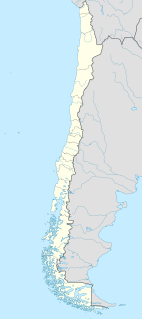
In Colonial times the Spanish Empire diverted significant resources to fortify the Chilean coast as a consequence of Dutch and English raids. During the 16th century the Spanish strategy was to complement the fortification work in its Caribbean ports with forts in the Strait of Magellan. As attempts at settling and fortifying the Strait of Magellan were abandoned the Spanish began to fortify the Captaincy General of Chile and other parts of the west coast of the Americas. The coastal fortifications and defense system was at its peak in the mid-18th century.
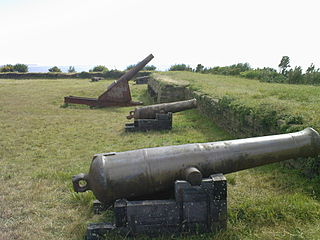
The Fort Agüi, also written as Agui or Ahui, and known as San Miguel de Agüi Castle, is a fortification located on the Lacuy peninsula, Chile.

The Spanish Empire attempted to settle the Strait of Magellan in the 1580s with the aim to control the by then only known passage between the Atlantic and Pacific oceans. The project was a direct response to Francis Drake's unexpected entrance to the Pacific using the strait in 1578 and the subsequent havoc his men wreaked upon Spanish America's Pacific coast. The colonizing project materialized as a naval expedition led by veteran explorer Pedro Sarmiento de Gamboa which set sail from Cádiz on December 1581. The expedition founded two short-lived settlements in the strait, Nombre de Jesús and Ciudad del Rey Don Felipe. The settlers proved poorly prepared for the cool and windy environment of the strait, and starvation and disease was soon rampant. A resupply expedition assembled in Río de Janeiro in 1585 by Sarmiento was unable to reach the strait given adverse weather. Aid to the failing colony was later hampered by Sarmiento falling prisoner to English corsairs in 1586 and likely the increasing strain on Spain's resources as a result of Philip II's wars with England and Dutch rebels. The last known survivor was rescued by a passing ship in 1590.


















